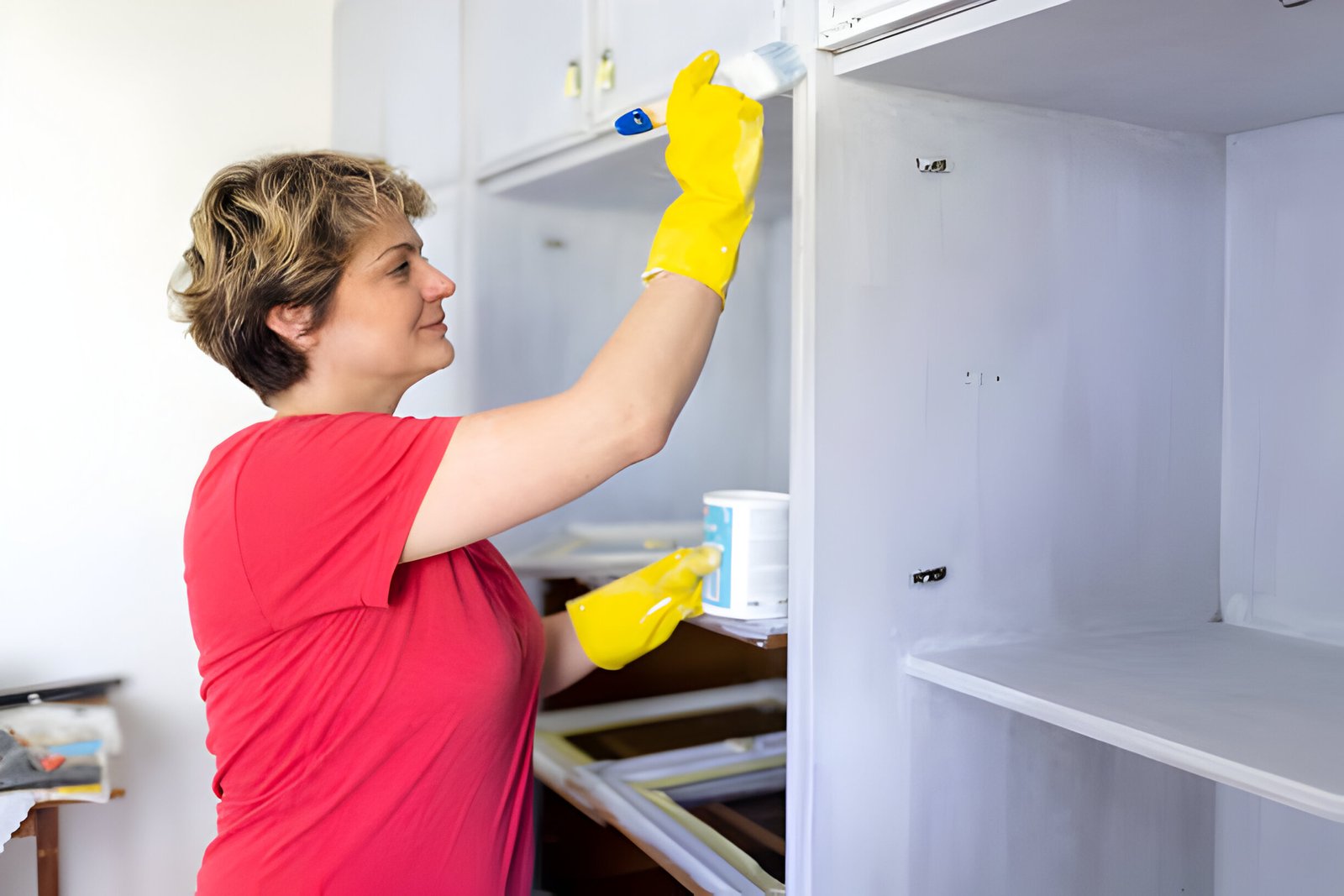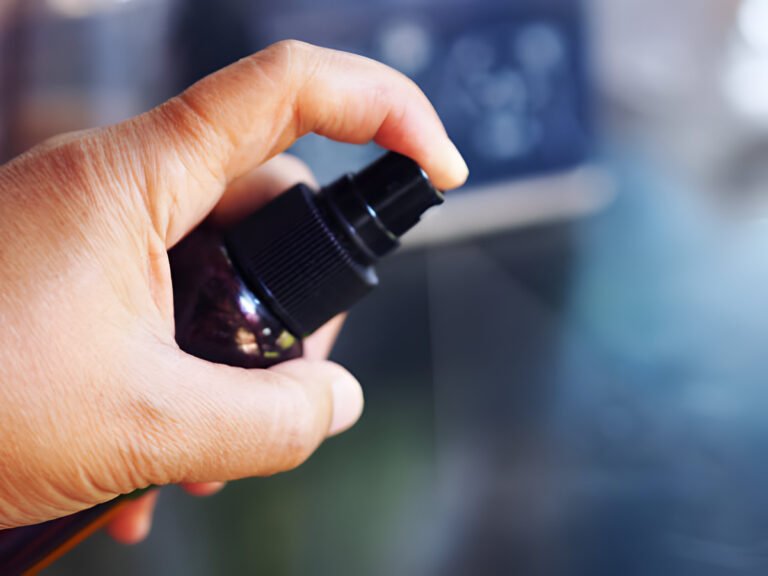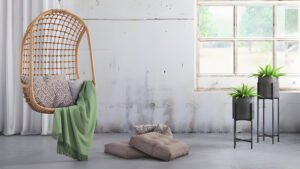Image Credit: Getty image
Revitalizing your kitchen doesn’t always require a complete remodel. Cabinet painting stands out as a cost-effective way to breathe new life into your space, drastically enhancing the appearance of your kitchen cabinets. With the right techniques and materials, including high-quality latex paint and a durable primer, homeowners can achieve professional-level results that not only elevate the aesthetics of their kitchen but also improve the durability and coverage of their cabinets. The process of selecting the best paint for kitchen cabinets and applying it correctly can significantly affect the adhesion, leveling, and overall finish, ensuring that the cabinets not only look beautiful but also withstand the test of time.
This article will guide you through the essential steps and techniques for cabinet painting, starting from the materials needed for a cabinet painting project to the initial preparation steps that are crucial for ensuring good adhesion and wood grain coverage. It will detail how to properly prime your cabinets, a step that enhances the paint’s durability and coverage. Various painting techniques tailored for cabinets will be discussed, including recommendations for products like Benjamin Moore Advance for optimal results. Additionally, we’ll cover finishing touches that add to the longevity and aesthetic of your kitchen cabinets, alongside maintenance tips to keep them looking their best. Whether you’re repainting cabinets or embarking on a new painting project, this comprehensive guide will provide you with the knowledge to achieve stunning results.
Materials Needed for a Cabinet Painting Project
To ensure a successful cabinet painting project, gathering the right materials and tools is crucial. This section outlines the essential types of paint and list of tools needed to achieve a professional and long-lasting finish on your kitchen cabinets.
Types of Paint
Choosing the right paint is pivotal for cabinet painting. There are several options available, each offering different benefits:
- Latex Paints: Known for their quick drying time and ease of cleanup, latex paints are a practical choice for many DIYers. They may not be as durable as oil-based paints but are less challenging to work with.
- Oil-Based Paints: These provide a durable and smooth finish, making them ideal for cabinets that endure frequent use. However, they require more cleanup and have a longer drying time.
- Hybrid Paints: Many major brands offer hybrid paints that combine the durability of oil-based paints with the ease of use of latex paints. Examples include Sherwin Williams Emerald Urethane Trim Enamel and Benjamin Moore Advance, which are highly recommended for their self-leveling properties and hard, enamel-like finish.
List of Tools
The right tools can significantly ease the process and improve the outcome of your painting project. Here’s a comprehensive list of tools you’ll need:
- Paint Brushes and Rollers: High-quality brushes and rollers ensure a smooth application. Consider different sizes for detailed areas and larger surfaces.
- Paint Sprayer: For a flawless finish, a paint sprayer like the HomeRight C800850 Max Pro Sprayer is recommended. It provides a fine finish that is superior to traditional methods.
- Sanding Tools: A small sander and 3M Small Area Sanding Sponge are essential for prepping the surface by smoothing out imperfections and ensuring better paint adhesion.
- Painter’s Tape and Drop Cloths: Use these to protect areas from paint splatters. Tape’n Drape Pre-Taped Mask Film and brown paper rolls are excellent for covering countertops and floors.
- Primer: A vital step in cabinet painting. Shellac-based primers or other high-adhesion options prepare the surface for painting, enhancing the paint’s durability and finish.
- Miscellaneous Tools: Items such as a power drill for removing hardware, paint can openers, stir sticks, and a paint pour spout will assist in the preparation and painting process.
Gathering these materials and tools before starting your cabinet painting project will help streamline the process, ensuring that you achieve the best possible results.
Initial Preparation Steps
Before embarking on the painting process, thorough preparation of the cabinets is crucial to ensure a flawless finish. This involves cleaning and sanding the surfaces meticulously.
Cleaning Cabinets
The first step in preparing your kitchen cabinets for painting is a comprehensive cleaning. This is essential for removing grease, grime, and any other residues that could impair paint adhesion. Start by removing all doors and drawers from the cabinet frames to access all surfaces easily. Use a high-quality degreaser or an all-purpose cleaner, applying it generously to all cabinet parts, including boxes, doors, and drawers. Be thorough in cleaning, paying special attention to areas that accumulate more grease, such as above and around the stove.
After scrubbing, rinse the surfaces with clean water and wipe them down with a dry cloth to remove any lingering cleaner residue. For particularly stubborn areas, consider using a stronger cleaning agent like trisodium phosphate (TSP) or a specialized product like Krud Kutter, which effectively cuts through heavy grease. Ensure that all surfaces are completely dry before moving on to the next step.
Sanding the Surface
Once the cabinets are clean and dry, the next crucial step is sanding. Sanding not only helps to smooth out the surface but also enhances the primer and paint’s ability to adhere effectively. Begin with a coarse grit sandpaper (around 80-100 grit) to strip away any old paint or finish. This is particularly important if the cabinets have a thick layer of old paint or a glossy finish that new paint would struggle to cover.
Progress to a medium grit (120-150 grit) to smooth the surface further. Always sand in the direction of the wood grain to avoid scratches that could show through the final painted finish. For areas with intricate designs or tight corners, use a sanding sponge or a hand sander to ensure even coverage.
After sanding, it’s vital to remove all dust and debris from the surfaces. A vacuum with a brush attachment works well for this purpose, followed by wiping down with a tack cloth, which helps pick up any remaining fine particles. This step is crucial as any remaining dust can prevent smooth paint application and may lead to an uneven finish.
By following these detailed steps for cleaning and sanding, one prepares their kitchen cabinets optimally for the subsequent priming and painting stages, setting the foundation for a beautifully refreshed look.
Priming the Cabinets
Types of Primer
When choosing the primer for kitchen cabinets, it’s essential to select one that provides strong adhesion, especially for surfaces that will be heavily used. Among the recommended products, Zinsser B-I-N Shellac-Base Primer stands out for its excellent adhesion properties. This primer is particularly effective on hard, slick surfaces including glass, tile, and plastic, making it ideal for kitchen environments where durability is key. It is known for its ability to block stains and prevent tannins from wood, such as from oak cabinets, from bleeding through the paint. Other notable options include oil-based primers like Zinsser Cover Stain, which are praised for their ability to seal surfaces and cover stains effectively.
For those seeking a balance between ease of use and durability, hybrid acrylic urethane primers offer properties of both oil-based and water-based primers. However, if sensitivity to odors or a preference for easy cleanup is a concern, water-based acrylic or latex primers might be the best choice, despite their lower durability compared to oil-based options.
How to Apply Primer
The application of primer is a critical step that can significantly influence the final outcome of your painting project. The process begins with ensuring the cabinets are impeccably clean. Using a strong degreaser like Krud Kutter or TSP is recommended to remove all dust, grease, and grime. Once cleaning is complete, the next step is to scuff up the surface slightly. While some primers claim no sanding is necessary, taking the extra step to lightly sand or use a liquid deglosser can enhance the primer’s grip, providing a more durable base for the paint.
- Application Technique: Start by applying a thin coat of primer using a brush or roller. For oil-based primers like Zinsser B-I-N, consider using a disposable brush as they are challenging to clean and quick-drying. Immediately after brushing, go over the primer with a foam roller to achieve a smooth finish. This step needs to be done swiftly as the primer dries quickly.
- Sanding Between Coats: Once the primer is dry, lightly sand the surface with high grit sandpaper (around 220 grit). This helps to smooth out any drips or brush marks and ensures a flawless base for the topcoat. After sanding, it is crucial to wipe down the surfaces with a tack cloth to remove all sanding dust.
By meticulously following these steps, one can ensure that their kitchen cabinets are well-prepared for the final paint application, leading to a more professional and durable finish.
Painting Techniques for Cabinets
When it comes to achieving a professional finish on kitchen cabinets, the choice of painting technique plays a pivotal role. Here, we explore three effective methods: brushing, using rollers, and spray painting. Each technique offers unique benefits and can be chosen based on the finish you desire and the tools you have at your disposal.
Brushing
Brushing is a traditional method that allows for meticulous application, especially in detailed areas. For the best results, it’s crucial to select high-quality brushes. Purdy brushes are highly recommended for their ability to leave a smooth finish with minimal brush strokes. When using a brush, one should apply paint in a consistent direction to avoid visible marks. Between coats, lightly sanding the surface helps to maintain a smooth finish. Adding a paint conditioner, like Floetrol for latex paints or Penetrol for oil-based paints, can enhance the paint’s flow and level out the finish, reducing brush marks.
Using Rollers
Rollers are ideal for covering large flat surfaces quickly. The type of roller used can significantly affect the finish:
- High Density Foam Rollers offer a smooth, lint-free finish, ideal for achieving a polished look without imperfections.
- Flocked Foam Rollers are known for their dense and soft texture, providing an even, spray-like finish.
- Velour Rollers and Mohair Blend Rollers are recommended for their smooth application and minimal stippling effect. These rollers are particularly effective with alkyd enamel paints, known for their durability and smooth finish.
When using rollers, it’s essential to apply the paint evenly and manage the amount of paint on the roller to avoid drips or uneven coverage. After applying the first coat, it’s advisable to sand lightly before applying the next coat to ensure a flawless finish.
Spray Painting
Spray painting is the quickest method to achieve a factory-like finish. Using devices like the Wagner Flexio 5000, one can cover large areas uniformly. The key to successful spray painting lies in adjusting the paint flow and speed to avoid drips and ensure even coverage. It’s important to maintain a consistent distance and speed during application. For intricate areas or edges, using a smaller attachment or adjusting the nozzle can help control the spray, reducing overspray and waste.
Regardless of the method chosen, proper preparation of the surface, including cleaning, sanding, and priming, is crucial to ensure that the paint adheres well and lasts long. Each technique requires specific tools and approaches, but with careful execution, one can achieve a durable and visually appealing finish on their kitchen cabinets.
Finishing the Cabinets
Once the initial layers of primer and paint are applied, the finishing steps are crucial to achieving a professional and lasting finish on kitchen cabinets. These steps involve applying additional coats of paint and conducting final sanding and polishing to ensure a smooth, durable surface.
Applying Additional Coats
To ensure complete coverage and enhance the durability of the paint, applying additional coats is essential. Start by assessing the first coat once it’s dry to the touch. If the underlying color or wood grain is still visible, or if there are any inconsistencies, additional layers may be necessary. For light-colored paints over dark surfaces, more coats will likely be required to achieve a uniform appearance.
- Additional Layers for Coverage: Apply the second coat of paint, ensuring to cover any areas that might have been missed or appear thin. It is generally recommended to apply at least two coats of paint, but three might be necessary for optimal coverage and to eliminate any underlying tones or brush marks.
- Drying Time Between Coats: Allow each coat to dry completely, which may take up to two days depending on the humidity and temperature. This waiting period is crucial to prevent the new coat from disturbing the underlying layer, which can lead to smudges or uneven textures.
- Technique for Even Application: Use a high-quality brush or roller to apply the paint, starting from the center of the cabinet and moving outward to the edges. This method helps to maintain a consistent thickness and prevents the buildup of excess paint along the edges.
Final Sanding and Polishing
After the final coat of paint has been applied and thoroughly dried, the next step is to sand and polish the cabinets to achieve a flawless finish.
- Light Sanding Between Coats: If additional coats were applied, light sanding with high-grit sandpaper (220-grit or higher) is recommended between layers. This helps to remove any imperfections such as drips, brush marks, or unevenness, ensuring a smooth base for subsequent coats.
- Final Touches: Once the last coat has dried, conduct a final light sanding over the entire surface. This not only helps to achieve an ultra-smooth finish but also prepares the surface for polishing.
- Polishing for Shine and Protection: Applying a polish or finishing wax can enhance the sheen of the cabinets and provide an additional layer of protection. Use a soft cloth to apply the polish in circular motions, focusing on one section at a time to ensure an even coat.
By meticulously following these steps for applying additional coats and performing final sanding and polishing, homeowners can ensure that their painted kitchen cabinets have a beautiful, durable finish that will last for years.
Maintenance Tips for Painted Cabinets
Maintaining painted cabinets not only keeps them looking their best but also extends their lifespan. Here are essential tips for regular care and handling damage to ensure your painted cabinets remain in excellent condition.
Regular Care
- Routine Cleaning: Dust and clean painted cabinets regularly using a soft microfiber cloth to avoid scratching the paint. For everyday dirt and spills, a mild solution of warm water and a few drops of gentle dish soap works effectively. It’s crucial to dry the surfaces immediately after cleaning to prevent moisture damage.
- Avoid Harsh Chemicals: Steer clear of abrasive cleaners and harsh chemicals that can strip the paint. For tougher stains, a solution of warm water and baking soda can be gently applied with a soft cloth. Rinse and dry thoroughly afterward.
- Protective Coatings: Applying a clear coat of non-yellowing polyurethane can provide an extra layer of protection against wear and tear. This step is particularly beneficial in high-traffic areas or where the cabinets are frequently touched.
- Climate Control: Maintain a stable indoor climate with temperatures around 70 degrees Fahrenheit and humidity levels between 40-50%. This helps prevent the wood from expanding or contracting, which can cause cracks and damage to the paint.
- Sunlight Protection: To prevent discoloration and fading, shield painted cabinets from direct sunlight with blinds or curtains. Prolonged exposure to UV light can degrade the paint over time.
Handling Damage
- Immediate Repairs: Address chips, scratches, or other damages promptly to prevent further deterioration. Use a touch-up kit that matches the paint color and finish of your cabinets for best results.
- Regular Inspections: Check for signs of wear or damage, such as loose hinges or hardware, which can cause additional stress on the painted surfaces. Tighten or replace any faulty components as needed.
- Gentle Use: Avoid hanging damp towels over cabinet doors or using the cabinets as a support for leaning or sitting. These practices can lead to peeling paint and weakened joints.
- Professional Assistance: For significant damage or refinishing needs, consult with a professional. They can assess the extent of the damage and perform repairs that blend seamlessly with the existing finish.
By implementing these maintenance tips, homeowners can preserve the beauty and functionality of their painted kitchen cabinets, ensuring they continue to enhance the home’s aesthetic for years to come.
Conclusion
Through the exploration of cabinet painting techniques, materials, and maintenance, this article has elucidated the transformative power of paint in refreshing kitchen spaces. From selecting the right paint and tools to meticulous preparation and application methods, we’ve underscored the crux of achieving a lasting and appealing finish. Emphasizing the significance of proper priming and choosing between brushing, rolling, and spray painting, we’ve provided a roadmap for homeowners to not only elevate the aesthetics of their kitchens but also enhance the durability of their cabinets.
As we conclude, it’s evident that with the right approach, painting kitchen cabinets can be an enriching DIY project that not only revitalizes the heart of the home but also adds value. While the technical aspects of painting are paramount, the broader implications of this work remind us of the joy and pride that come from personalizing our living spaces. Hence, we encourage further exploration and creativity within this realm, suggesting that the journey of transforming one’s kitchen can extend beyond mere aesthetics to become a deeply meaningful undertaking. In doing so, homeowners forge a connection with their space that truly reflects their taste and style.
FAQs
1. What steps are involved in painting kitchen cabinets flawlessly?
To achieve flawless painted kitchen cabinets, begin by removing all doors and hardware. Place the doors on clean drop cloths. Thoroughly clean the surfaces, then sand each door. Apply a high-quality primer designed for cabinets. Proceed to paint the cabinets, and after painting, allow ample time for the paint to cure.
2. What type of paint do professionals prefer for kitchen cabinets?
Professional painters often opt for professional-grade lacquer due to its smooth, silky finish, which is similar to the finish used by cabinet manufacturers. While this is the preferred choice, there are also high-quality water-based paints that are excellent for cabinet painting.
3. What is the most effective technique for painting cabinets?
For optimal results in painting cabinets, use a brush to cut in along the edges and corners, minimizing visible roller strokes. Use a roller to apply enamel paint to the larger flat surfaces. For the interiors of the cabinets, use a smooth-surface mini roller to achieve a slightly textured, orange-peel finish.
4. Which paint finish is most suitable for kitchen cabinets?
The best finishes for kitchen cabinets are semi-gloss, gloss, or satin. These finishes are durable and easier to clean, making them ideal for kitchen environments. Matte finishes are less practical for kitchens due to their lack of durability and difficulty in cleaning. Regardless of the paint type chosen, proper preparation is crucial to achieving a good finish.
























Thanks for sharing. I read many of your blog posts, cool, your blog is very good.